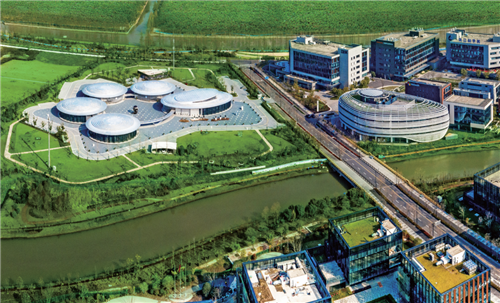Shanghai's Zhangjiang zone: A hub for nation's innovative talents

The Zhangjiang zone in Shanghai has made remarkable achievements after 10 years of development, and has grown into a hub for innovative talents in the country. [Photo/china-shftz.gov.cn]
The Zhangjiang National Innovation Demonstration Zone in East China's Shanghai has implemented new favorable policies to attract more talents, and rules for obtaining a hukou - permanent household registration - are being eased in the zone, according to a local news report on April 8.
The zone is currently home to 41,200 employees, with more than 60 percent of them having a college degree or above.
Zhangjiang is now home to 22,000 enterprises, the regional headquarters of 62 multinationals, and nearly 1,700 high-tech enterprises, including Semiconductor Manufacturing International Corp, or SMIC, Swiss pharma giant Roche, and MicroPort Scientific Corp. In 2020, the zone achieved a regional GDP of 303.35 billion yuan ($46.95 billion), an increase of 8.9 percent year-on-year.
Over the past 10 years, Zhangjiang has witnessed the building of a complete and advanced integrated circuit (IC) industrial chain. The zone currently houses more than 250 IC-related upstream and downstream firms, and the sales revenue of the Zhangjiang's IC companies topped 128.5 billion yuan in 2020, a year-on-year increase of 22.9 percent.
Hailed as China's "Pharma Valley", Zhangjiang accommodates more than 1,000 innovative biomedicine companies and a quarter of China's top 100 companies. Seven of the world's top 10 pharmaceutical companies have also set up their regional headquarters and research and development centers in Zhangjiang.
Among the companies is Liferiver, a diagnostics solution provider that specializes in polymerase chain reaction-based molecular diagnostics. The company's COVID-19 nucleic acid testing products, including test kits and equipment, have been used in more than 80 countries and regions.
The zone's development of artificial intelligence has also been sped up, with over 100 firms introduced to the Zhangjiang Artificial Intelligence Island in the zone.
The Zhangjiang zone is also a hub for the country's top scientific research institutions. It currently houses 14 mega science projects that are either in operation or under construction. There are 330 national research and development (R&D) institutions in the zone, such as the Tsung-Dao Lee Institute and the National Center for Protein Science (Shanghai), all of which help the zone become a comprehensive national sci-tech innovation center.
Zhangjiang will continue to leverage technological innovations to improve its capability for innovation and break through the bottleneck of core technologies, as well as foster high-end industries with the aim of becoming the country's frontier for scientific and technological innovation, a hub for breakthroughs in key technologies, and the main driving force for Shanghai's high-quality growth in the coming 10 years, according to local officials.


 Foreign investors have faith in China
Foreign investors have faith in China  The RCEP era begins
The RCEP era begins  Yangtze River Delta integration: 3 years on
Yangtze River Delta integration: 3 years on  play
play 